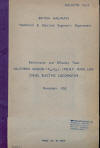




M Herd

|
This, the first Testing Bulletin to be issued for non-steam locomotive was set out in such a manner as to display the whole range of capacity, fuel consumption and efficiency of a representative main line Diesel Electric Locomotive, while at the same time facilitating comparison with other forms of motive power. Unlike the steam locomotive tests, a separate series of service tests were run in this case in addition to the analytical tests in the different notch positions, so as to examine in more detail the relationship between the designed power steps and the conditions in which they were actually used. The locomotive tested was in the form as originally designed except only that a change of gear ratio was made in between the different series of trials. As at first worked out by the former Southern Railway, emphasis was placed on high speed performance but at the schedules currently operating power for acceleration is of more importance. To provide this within permissible limits of heating of the electrical equipment, the gear ratio was accordingly altered from 52/21 to 65/17. Two stages of field weakening were provided in the latter case as against one stage in the former. The tests were carried out under the direction of Mr. R.A.Riddles, Member (Mechanical & Electrical Engineering) Railway Executive, the work being controlled by the Locomotive Testing Committee. NATURE OF THE TESTS The tests were carried out in two parts. Those of the first part were in the nature of observational tests on revenue earning trains in order to obtain average performance and efficiency values in representative service. Those of the second part were analytical in character designed to evaluate~ first~ the fuel consumption related to drawbar tractive effort and horsepower for the immediate commercial purpose of relating loadings and schedules to obtain maximum operating efficiency and, second transmission characteristics and efficiency, factors of more importance in design. Both types of tests were carried out on the road with the Western Region Dynamometer Car attached to the locomotive as the testing unit. TEST ARRANGEMENTS Service Tests The trains chosen were as follows : Down: 1-00pm. ex Waterloo to Exeter Central stopping at Woking, Andover Junc., Salisbury, Templecombe, Sherborne and Yeovil Junc. Up : 7-30am. ex Exeter Central to Waterloo stopping at Sidmouth Junc. Axminster, Yeovil Junc., Sherborne, Templecombe, Gillingham, Salisbury and Andover Junc. Tests were carried out on two trains in each direction. Analytical Tests The route chosen for these tests was that of the S.R. main line between Exeter Central and Salisbury, a section which is included in the gradient diagram below. Tests occupied four days, during which the daily loading varied between 390 tons for working in notches 7 and 8, down to 61 tons for notches 3 and 4 which correspond to the lightest train working conditions LOCOMOTIVE The locomotive concerned in both series of tests was No.10202. Completed in August 1951, after a period of trials and adjustments, it was put into regular service in October 1951. It was normally employed with sister loco No.10201 on express passenger trains between Waterloo and Exeter or Weymouth, making two round trips on the one or other route each day for six days a week. Here are a few pictures of the tests and a summary graph. |
Pictures are BR official except where credited